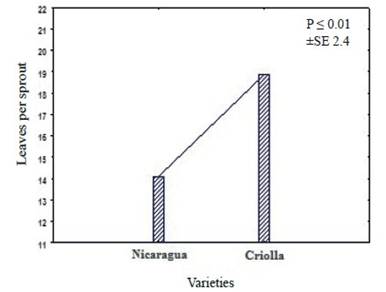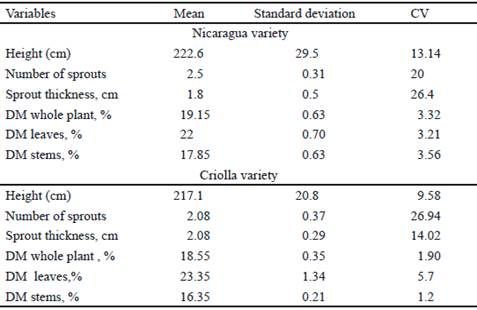The reproduction by gamic seed guarantees better root development and of the plant until the adult state, with tolerance to stress conditions (Godino et al. 2013), besides the saving of the workforce and reduction of the labor time during the sowing. However, when it is required to maintain genetic purity and there are no extensions of land that prevent cross-hybridization, the use of cuttings for sowing is viable, because it maintains the genetic identity of progenitors, although the plants take up to six months to produce seeds (Pérez et al. 2010). This type of reproduction is used mainly for the production of forage plantlets (Pérez et al. 2010).
The cuttings planting method has specific requirements, which are inherent to the cuttings in particular, so that regrowth is effective (Osorio and Marulanda 1987). Among them are the species, variety and age of mother plants, as well as having a diameter and height that allows the remobilization of nutrients for regrowth, from the nodes and number of nodes (minimum two).
Osorio and Marulanda (1987) recommended a length of 20 cm for sowing in this way, and suggested that each cutting had several buds, so that when planted there would be higher possibilities of sprouting. The cut can be made with scissors with distance of the first internode of 3 or 4 cm.
Starting from the benefits of extension that has the sowing by cuttings, this method is proposed for the extension of Moringa oleifera in fragile ecosystems and degraded by the intense seasonal drought. The purpose of its application is to guarantee irrigation during the sowing phase and to establish seed banks with genetic purity, which allows the evaluation of the productive potential of seeds from different varieties in the edaphoclimatic conditions of Valle del Cauto.
It is proposed to evaluate the percentage of sprouting and development of plantlets in two varieties of M. oleifera (Nicaragua and Criolla), planted with agamic seeds.
Materials and Methods
Location, climate and soil. The study was performed during 2014 at the Estación Experimental de Pastos y Forrajes (EEPF) from the Instituto de Investigaciones Agropecuarias "Jorge Dimitrov", located 10 ½ km from Bayamo city, Granma province. The facility is located at 20º 18'13 "north latitude and 76º 39' 48" west longitude.
The climate where the EEPF is located is classified as tropical, relatively humid (Barranco and Díaz, 1989). During the year of study, 924 mm were precipitated. Of them, 94.5 % in the rainy season, with an intensely dry period in the dry season (November-April).
The soil of the area is fluvisol, little differentiated, according to the new version of genetic classification of Cuba soils (Hernández et al.2015), whose characteristics are showed in table 1.
Plant material. Gamic seed from two varieties of M. oleifera (Criolla and Nicaragua) was used, from the seed bank located in the EEPF. The seeds were collected after pruning in one of the seed harvests. The latter came from the branches and cut stems.
Treatment, design and statistical analysis. As treatments, Criolla and Nicaragua varieties were considered, distributed in a randomized block design with four replications. The statistical analysis was carried out with the software Statistica version 10.0. The normality of data was determined from the Kolmogorov-Smirnov (Massey, 1951) criterion and the variance homogeneity from the Bartlett (Statsoft, 2010) test. An analysis of variance that followed the principles of the proposed mathematical model was carried out. The comparison of means was performed according to the Duncan (1955) test.
Experimental procedure. The study began in January 2014. The minimum preparation of the soil with animal traction (plowing, crossing, furrow) was carried out to reduce the possible affectation of the ecosystem. The sowing was carried out by a specialized team from the EEPF in 9 x 7 m plots, with separation between rows of 0.5 m and between plants 0.25 m. Cuttings of 35 cm in length and ± 4 cm in thickness were used. All were vertically planted, at a depth of 5 cm, immediately after being cut. During the whole experiment irrigation was applied, at a rate of 250 m3 ha-1 with the help of a sprinkler.
After four months of planting, an establishment cut was made at 10 cm high. At 96 d after the establishment cut, agronomic measurements were performed.
Measurements in the plant. Ten plants per replication were selected and the height of the plant from the base of the stem to the apex of the last leaf, the number of leaves per sprout, the weight of stems and young leaves and the number and thickness of sprouts were measured with a millimeter ruler. This last variable was measured with a vernier.
Once the measurements were carried out, the ten plants of each repetition corresponding to each treatment were manually cut. Leaves and stems were separately weighed and the leaf/stem ratio was determined. This relation was made in a 300 g sample, which was introduced in a 65 °C air circulation oven until constant weight was reached. The proportions of leaves and stems were used for the whole plant.
Results and Discussion
In the sprouting process, the Nicaragua variety significantly exceeded the Criolla variety (table 2).
With the agamic seeds, according to Osorio and Marulanda (1987), the main limitation is the relative humidity, which intervenes in the rooting process of the cutting. This determining factor is of vital importance because in the ecosystems from the humid tropics it is characteristic the high relative humidity that can affect the development process. However, with the strategic application of irrigation, the persistence and development of the crop can be guaranteed.
In these ecosystems, is also characteristic the presence of high temperatures that limit the sprouting process of the gamic seed (Muhl et al. 2011), besides stimulating the presence of insects and phytophages that affect and eliminate the seeds (Ledezma et al. 2015).
The differences between the varieties can be due to particular characteristics of each of them, which allow them to behave differently in the same environment (Benítez et al. 2010). Considering that the sprouting process involves the re-mobilization of reserves for the formation of new organs, it is assumed that the Nicaraguan variety is genetically predisposed to higher remobilization of soluble carbohydrates for vigorous regrowth (Strehle et al. 1994).
During the growing process, the morphology was also modified by the effect of the variety (figure 1). In this precision, only the number of leaves per sprout showed significant differences in favor of Criolla variety.
Having a higher number of leaves can provide the Criolla variety with higher photosynthetic efficiency and, therefore, supply the deficit of soluble carbohydrates according to the sprouting results, and thus guarantee the development of the plant (Herrera 1983).

Figure 1 Number of leaves per sprout in Nicaragua and Criolla varieties of M. oleifera at 96 days of pruning
Padilla et al. (2014) showed that the number of leaves/plant of Moringa increased with the increase in cut height. However, these authors obtained values lower than those of this study, which could be related to the morphological response of this plant in western Cuba. The differences in the cited results can be attributed to the climate and soil conditions that the West has with respect to the East.
The number of leaves in the sprouts determines the health of the plant during its development. It also offers the plant an added value, conditioned by the number of leaves and the nutritional quality it has. Yubero (2013) pointed out that Moringa can reach up to 30 % of protein in dry base and negligible content of secondary metabolites, which are the compounds that most influence and determine on the use of shrubs biomass. For this reason, the more leaves have a regrowth, more benefit will have the producer in supplying to the animals.
The rest of the morphological variables of the varieties under study did not show significant differences (p≥0.05), when the cut was made at 96 d (table 3). This suggests that sowing with agamic seed only affects the sprouting capacity of the varieties under study, and not the development of plantlets.
Tabla 3 General means of the morphological variables of the varieties under study at 96 days of pruning.

According to the average value of the plant height at 96 d of age, it is inferred that the Moringa varieties have accelerated growth, but this is, in turn, inherent in the varieties, and rather characterizes the genus. Sardiñas et al. (2016) agreed with this criterion when evaluating some agronomic variables and plant structure of four shrubs species, among which was the Moringa, and its height during the establishment, which was significantly superior to the rest of shrubs with which it was compared. These authors reported a growth rate of 1.34 cm per day, which makes the Moringa a fast growing species, in which the type of seed does not determine its performance. The scarce emergence of sprouts at 96 d of cutting the plant in both varieties can be related to the dominance of more developed sprouts, which demand more nutrients, combined with the effect of shade on the smallest, which causes death.
Similar performances reported Ybalmea et al. (2000), who related them to the increase in the age of the plant that allows an increase in the sprouts thickness, and is associated with the accumulation of reserves in carbohydrates form. The latter facilitates the plant to enter the accelerated growth phase and allows the stem to increase its thickness and size.
The dry matter (DM) content of leaves and stems (table 4), although it did not reach the statistical significance among varieties, surpassed that referred by Gallego et al. (2017) in whole plant of Tithonia diversifolia Hemsl. A Gray, planted in different ways, as is the case of the agamic seed.
The results of this variable also exceeded those obtained by Lezcano et al. (2012) in leaves and young stems in two climatic periods, at the age of 56 d. This effect, although in two different genus, could be determined by the relatively low DM content of Tithonia, compared to the results of this study. According to Alonso et al. (2012), cut age is an aspect to be taken into account when quantifying or estimating DM content, which is mainly due to the gradual histochemical transformations that occur in plants due to the effect of age (Ledea 2016).
Table 4 Percentages of leaves and stems and leaf/stem ratio in M. oleifera after 96 days of pruning.

The leaf/stem ratio is an aspect of vital importance in this type of crop, which is very dependent on the availability of water for the development of its vegetative cycle. Navarro et al. (2015) highlighted that as the water requirements of the plant are guaranteed, it will be able to produce fruits and maintain more leaves. With this condition, the climate season can determine the amount of leaves that may have (Godino et al. 2013).
The leaf/stem ratio for the two varieties at 96 d was considered diminished, since this response is a consequence of the maturity of the plant and the root development it reaches. However, if it is considers the type of seed that was used, it is logical that in the first ages the plant will not be able to express its potential. According to Pérez et al. (2010), when agamic seed is used, the plants take up to six months after planting to produce the fruits, that is, they take 180 days to accumulate the reserves that are remobilized and / or used for flowering and fruiting. After this time, the foliage must improve substantially, and with this the leaf/stem ratio also improves.
It is concluded that under the Valle del Cauto conditions the sowing of M. oleifera from agamic seed does not affect the development or the architecture of the plant.











 text in
text in 




